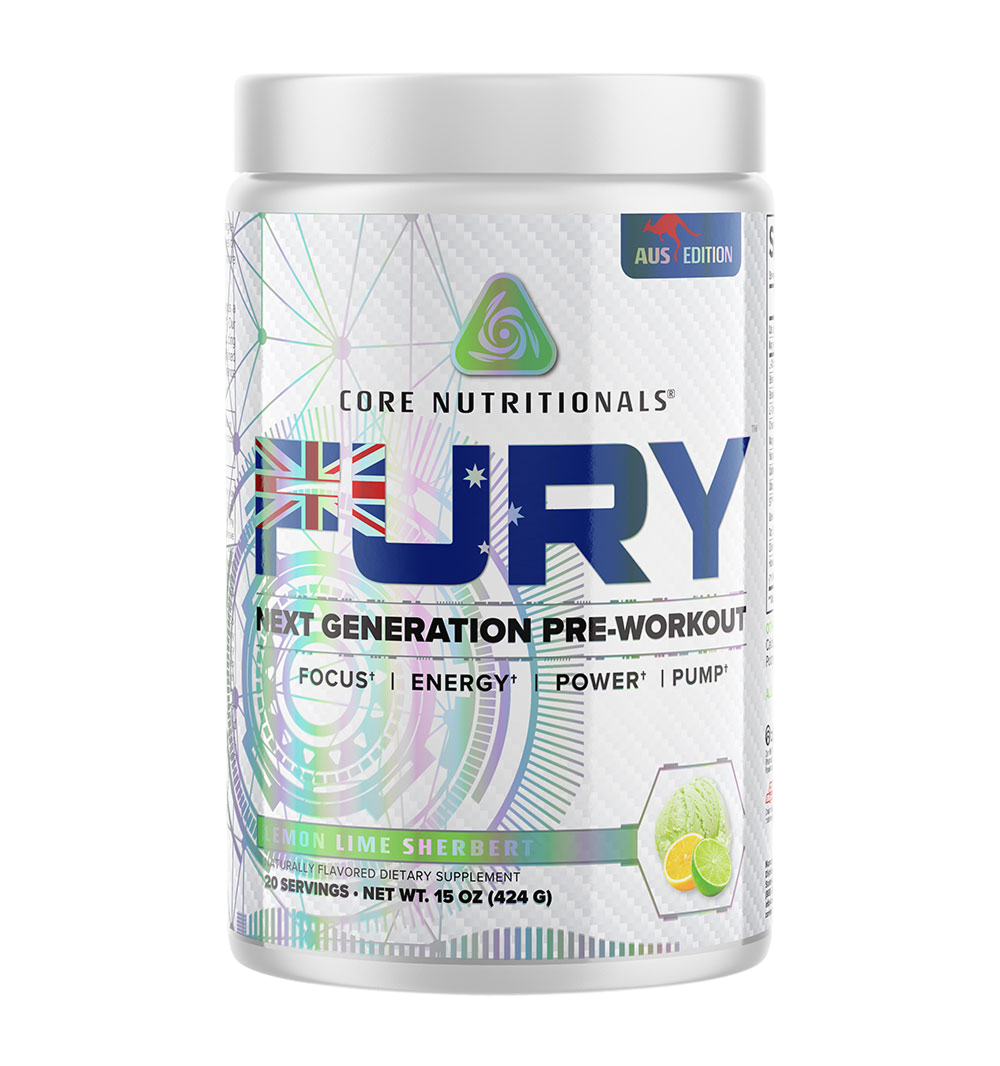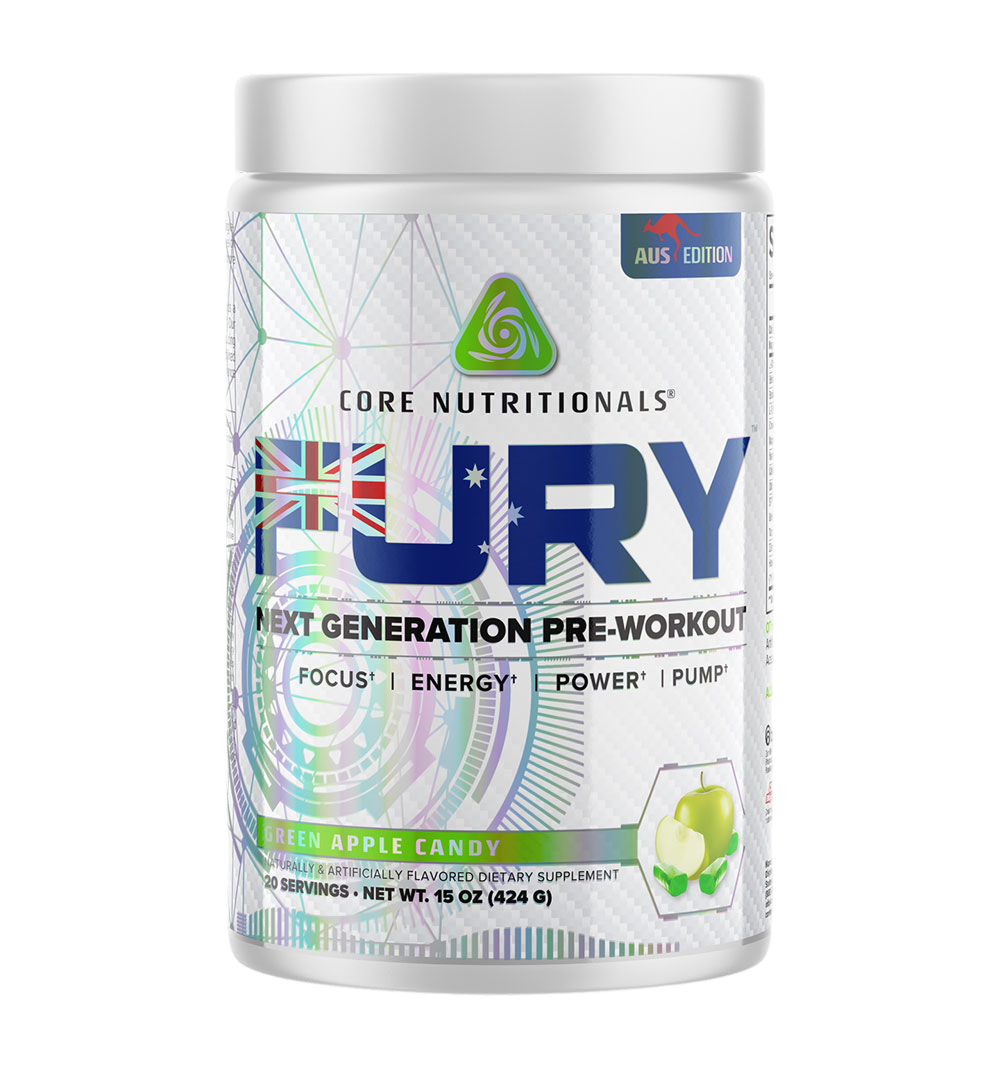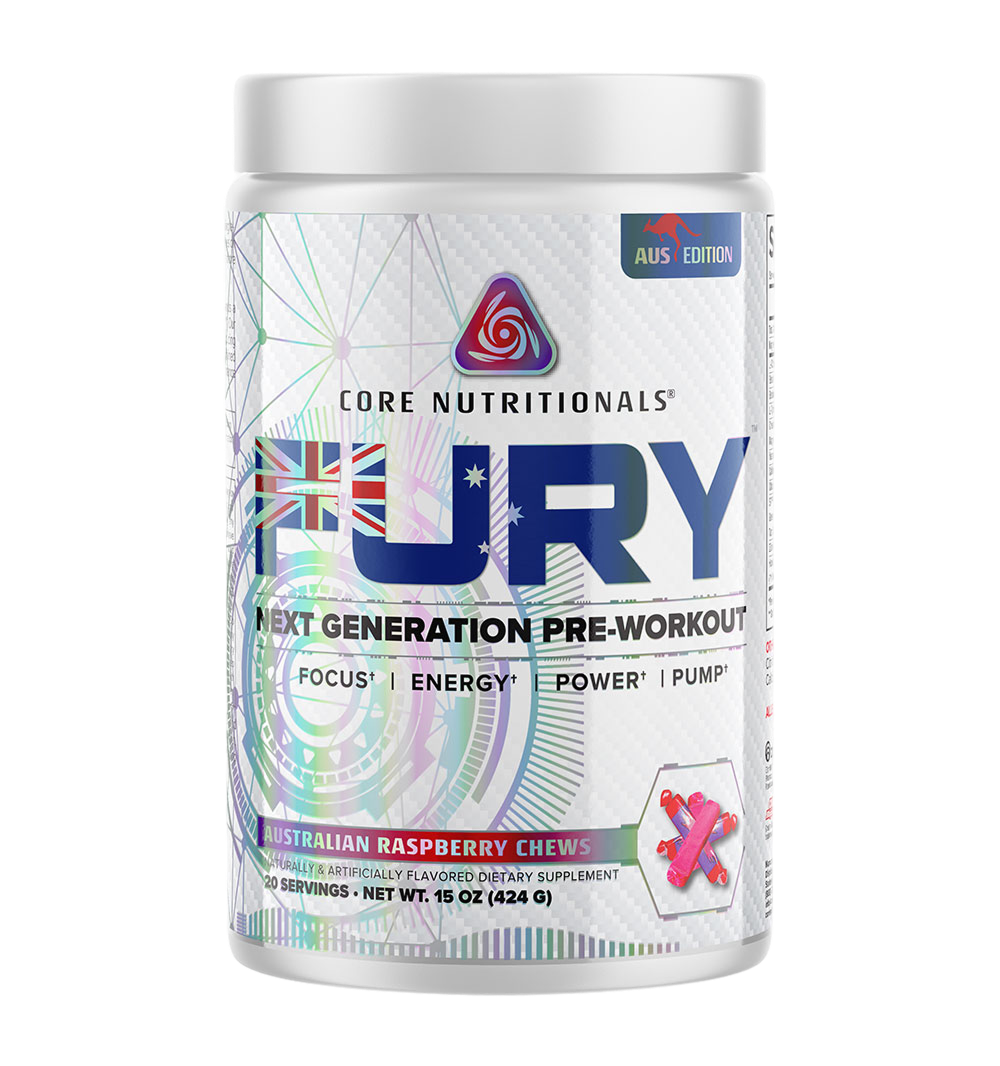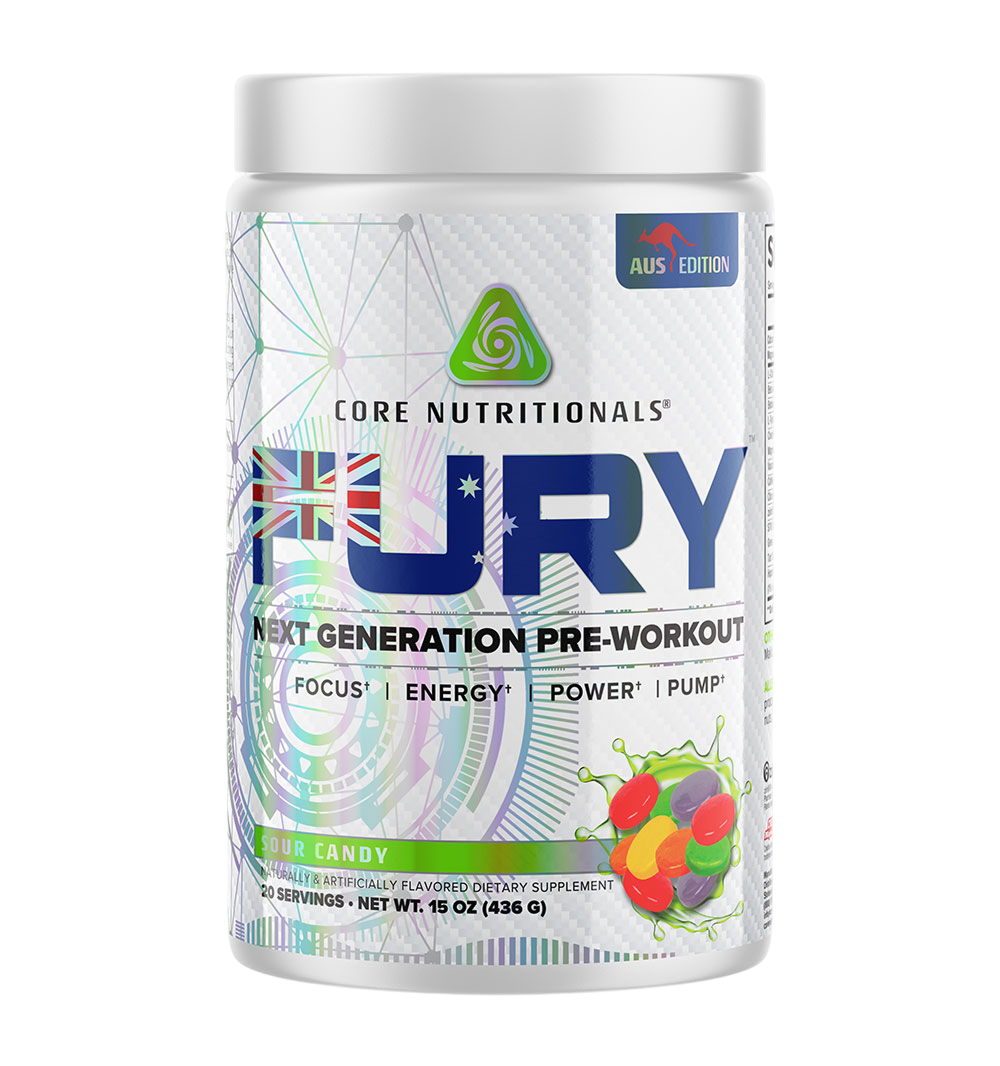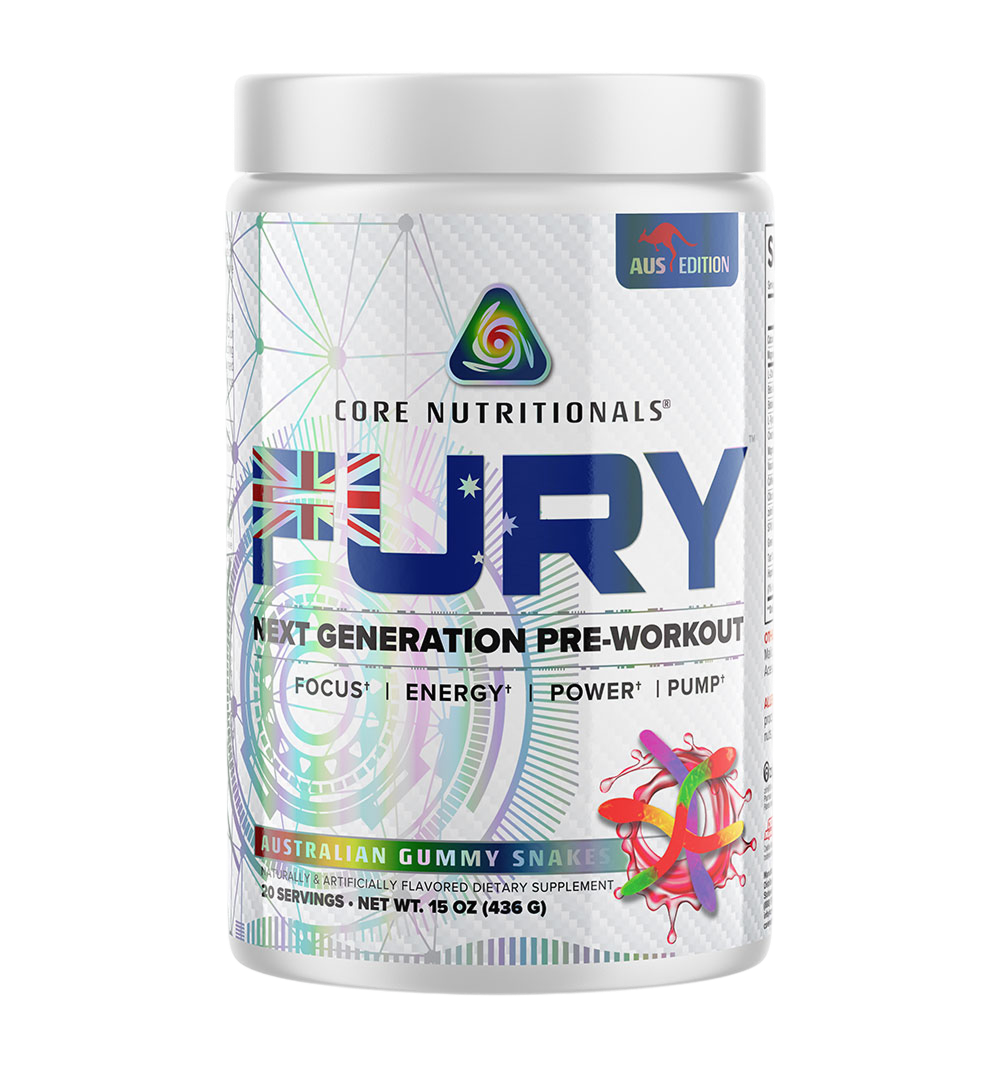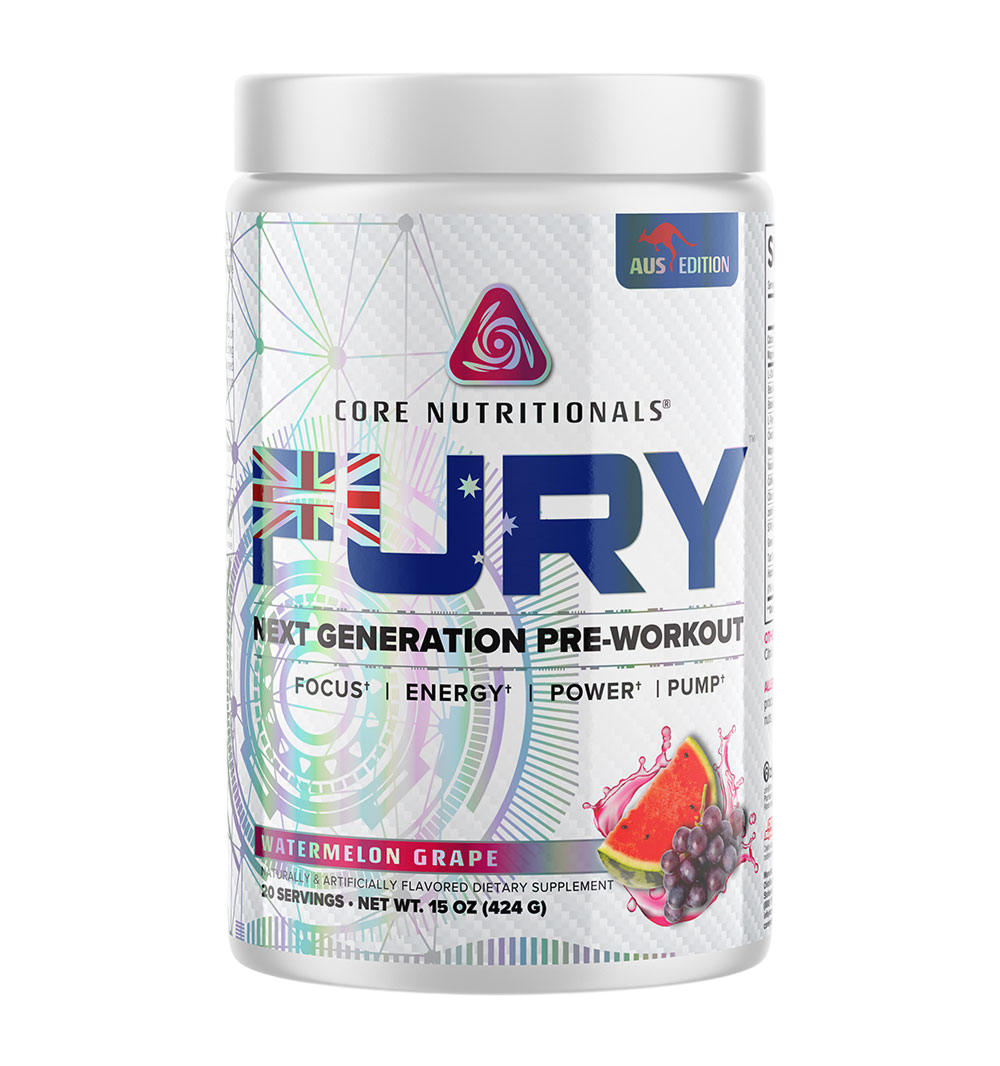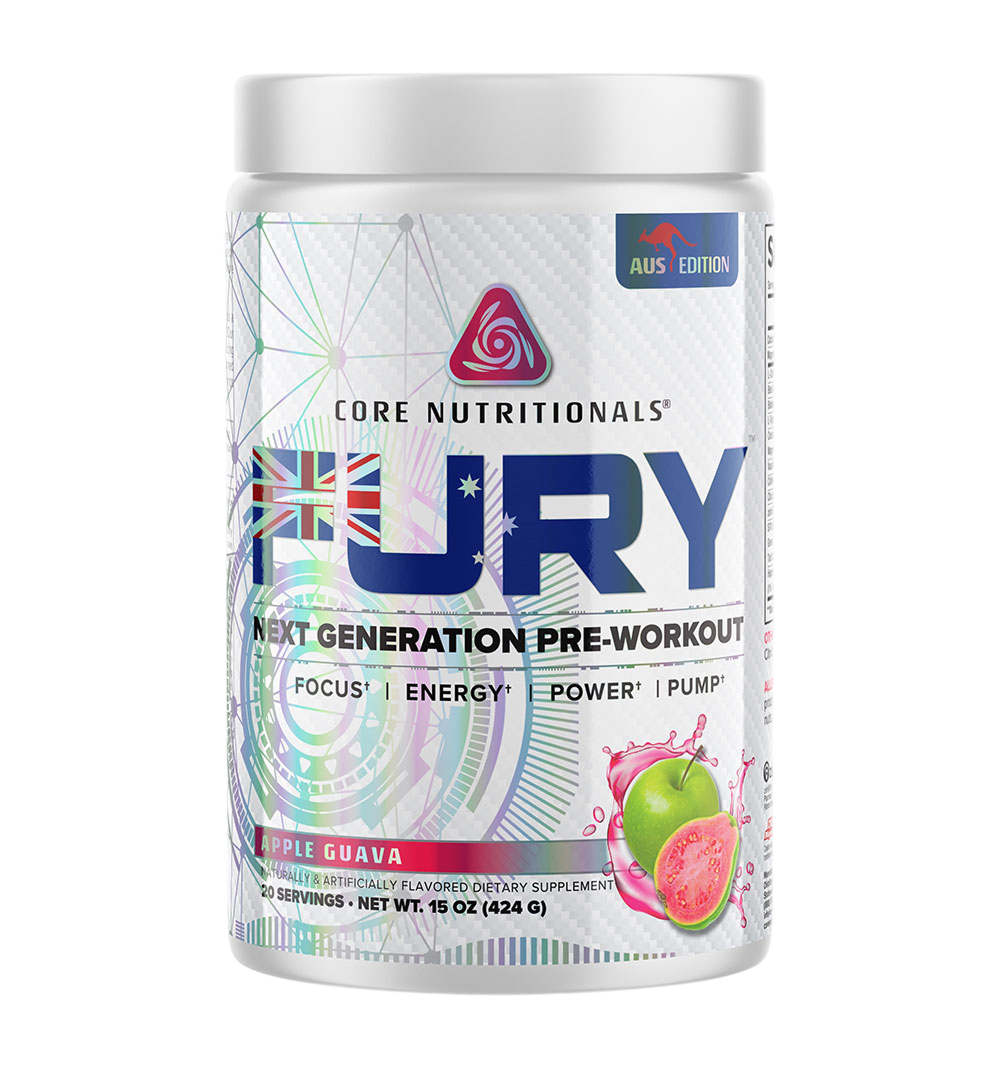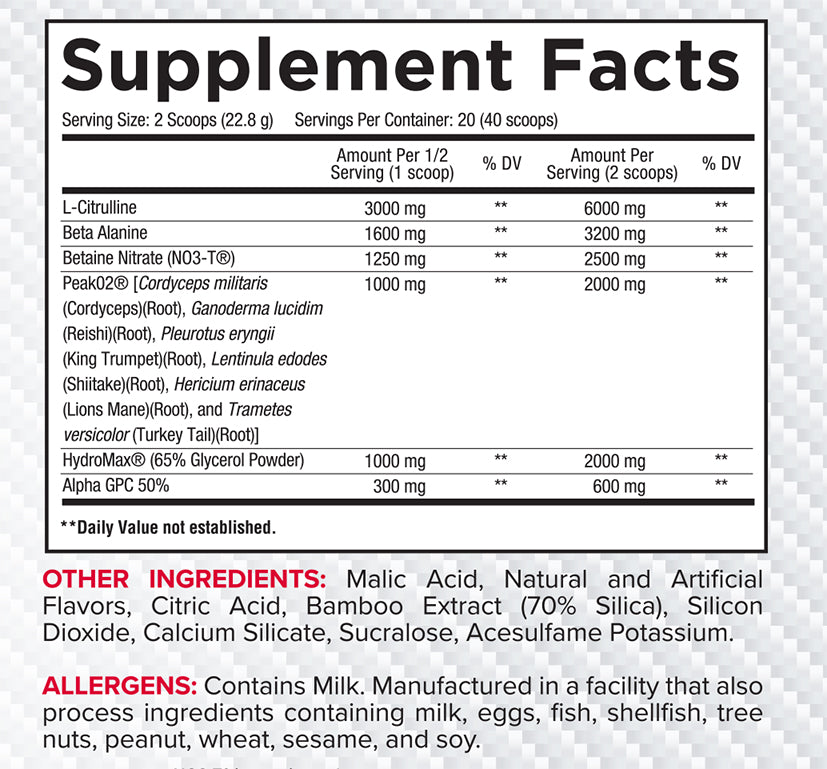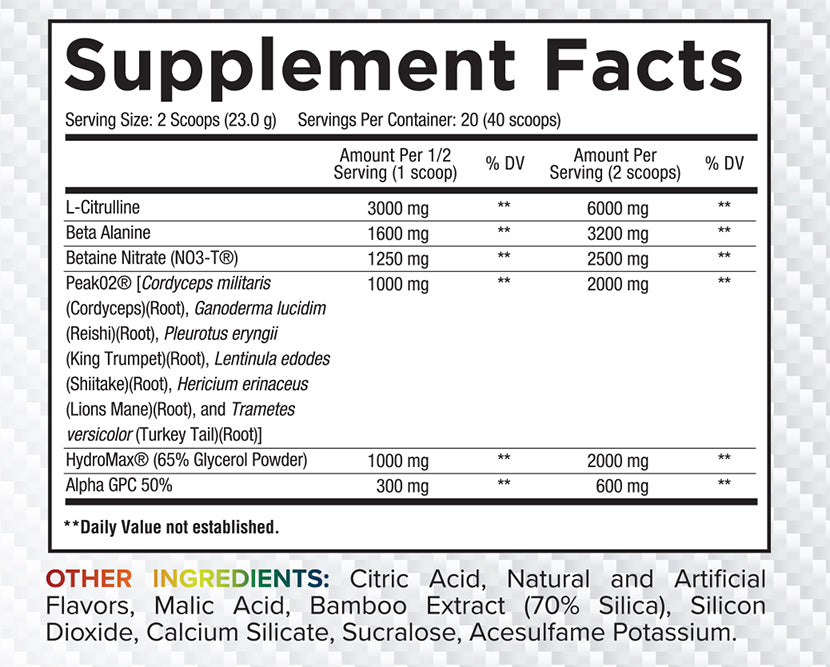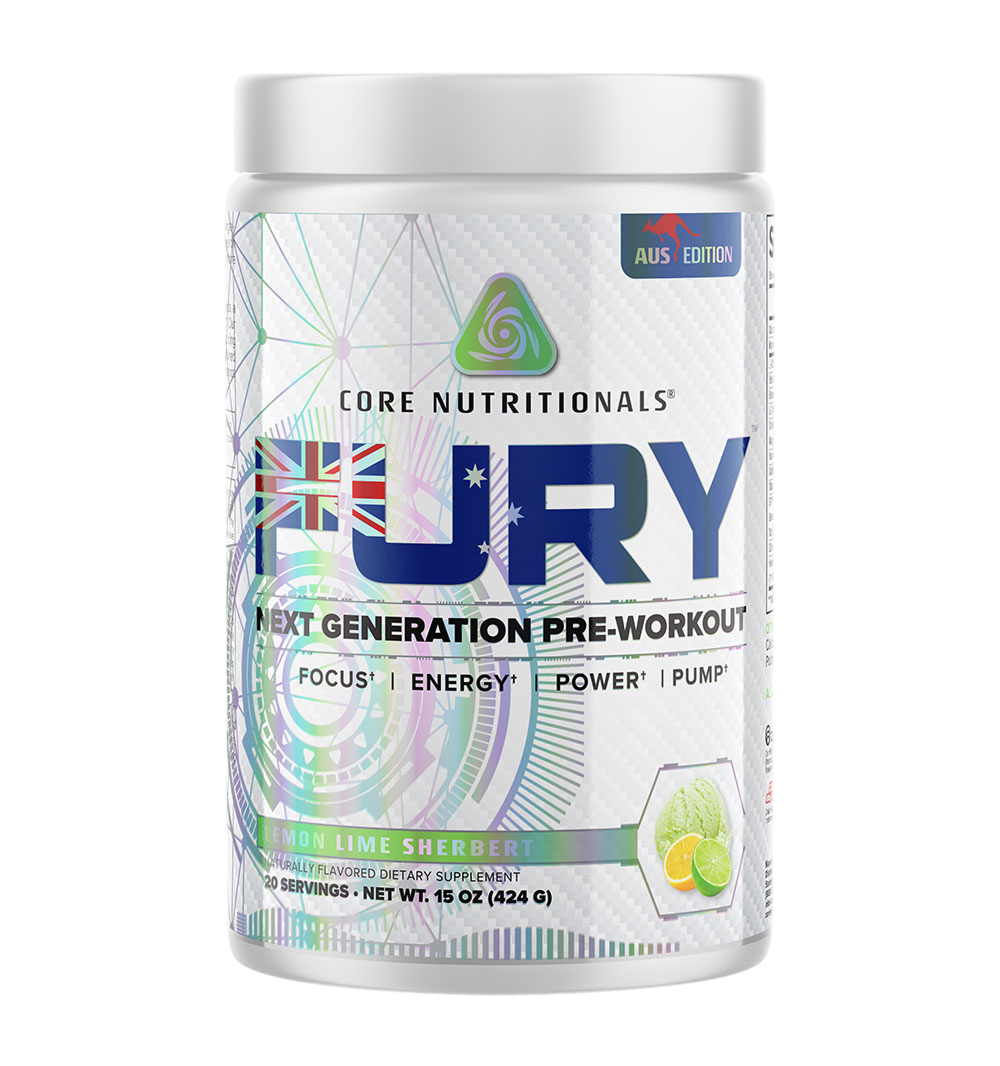
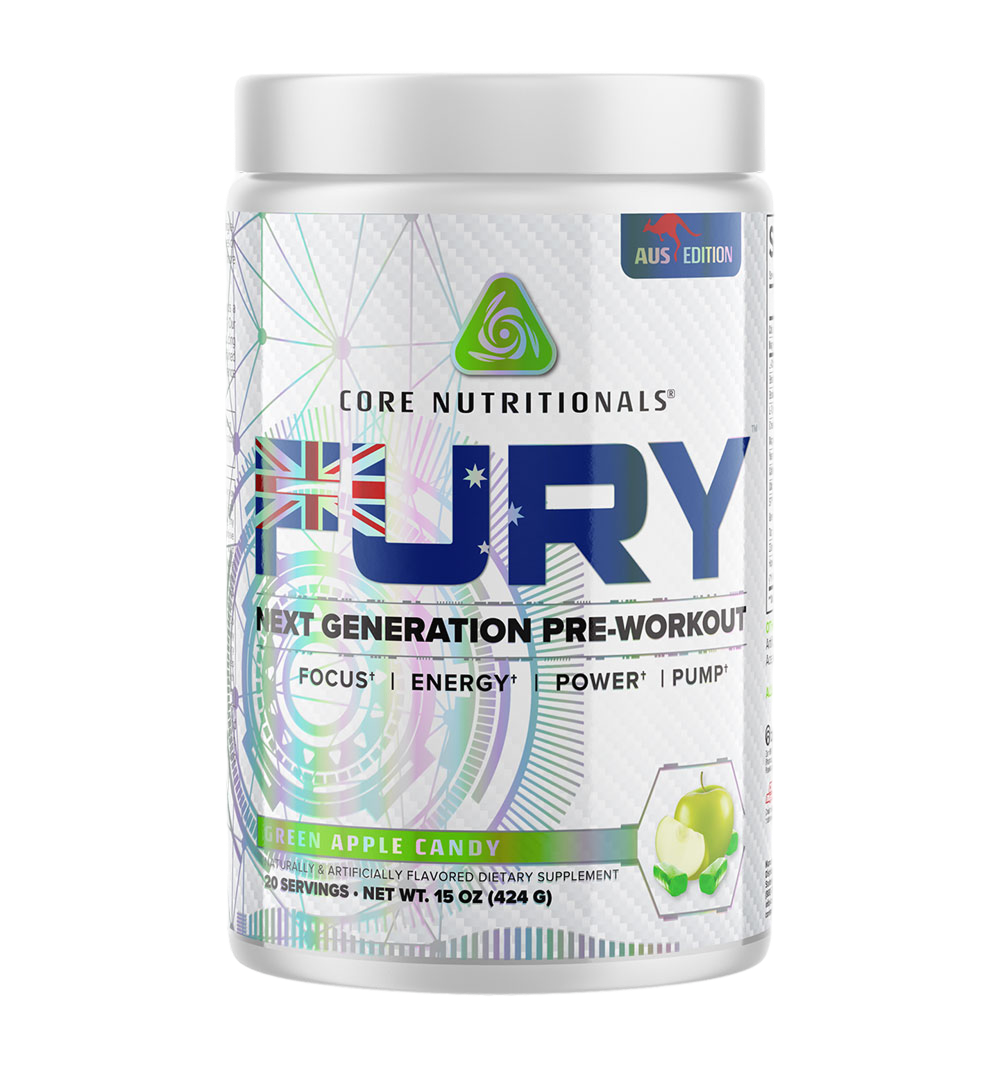
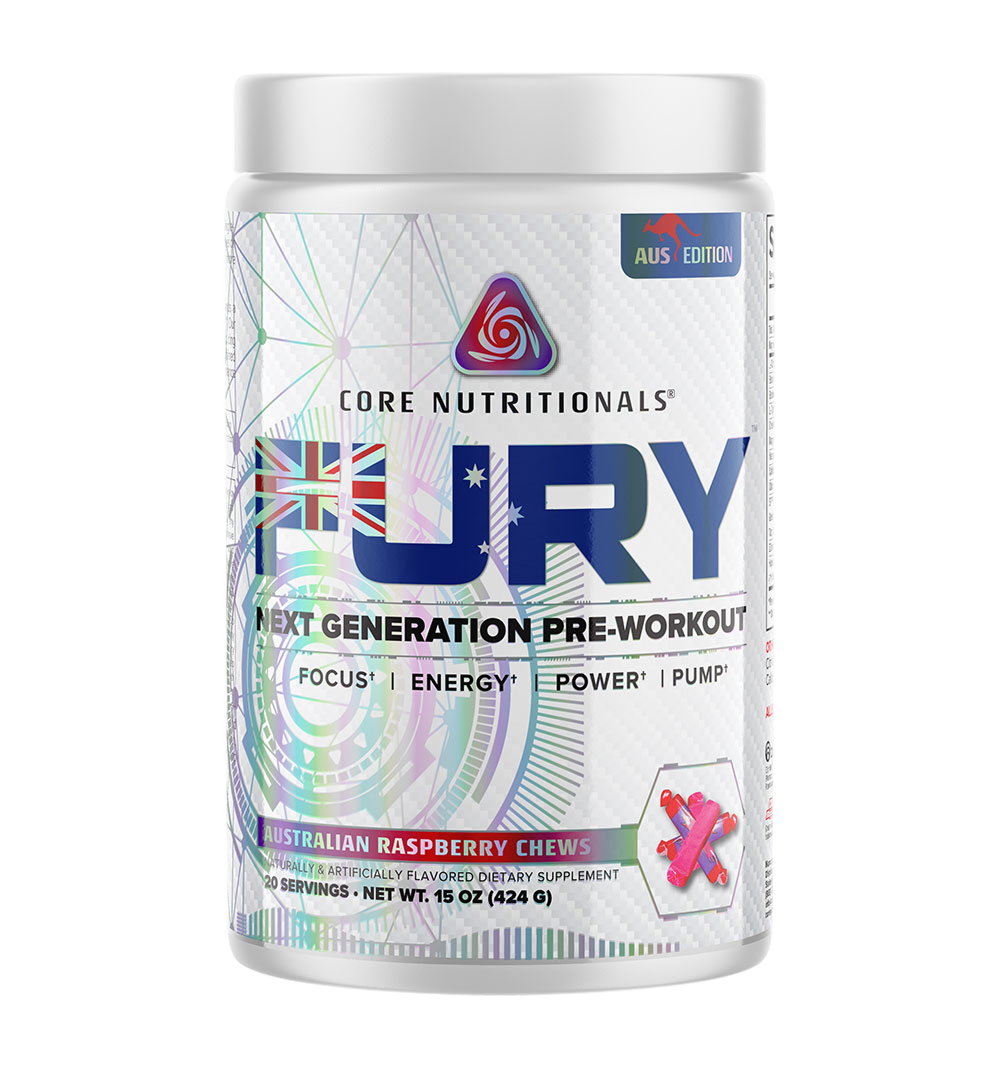
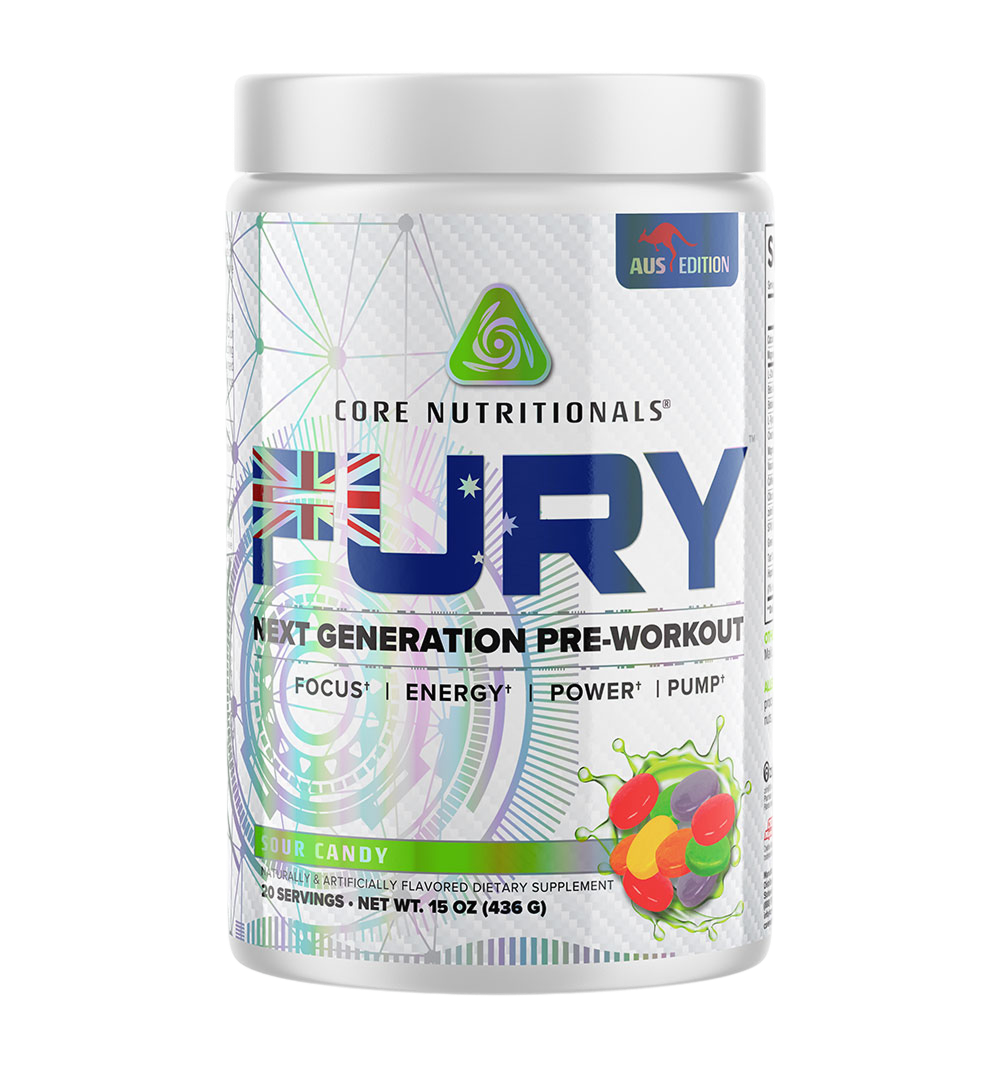
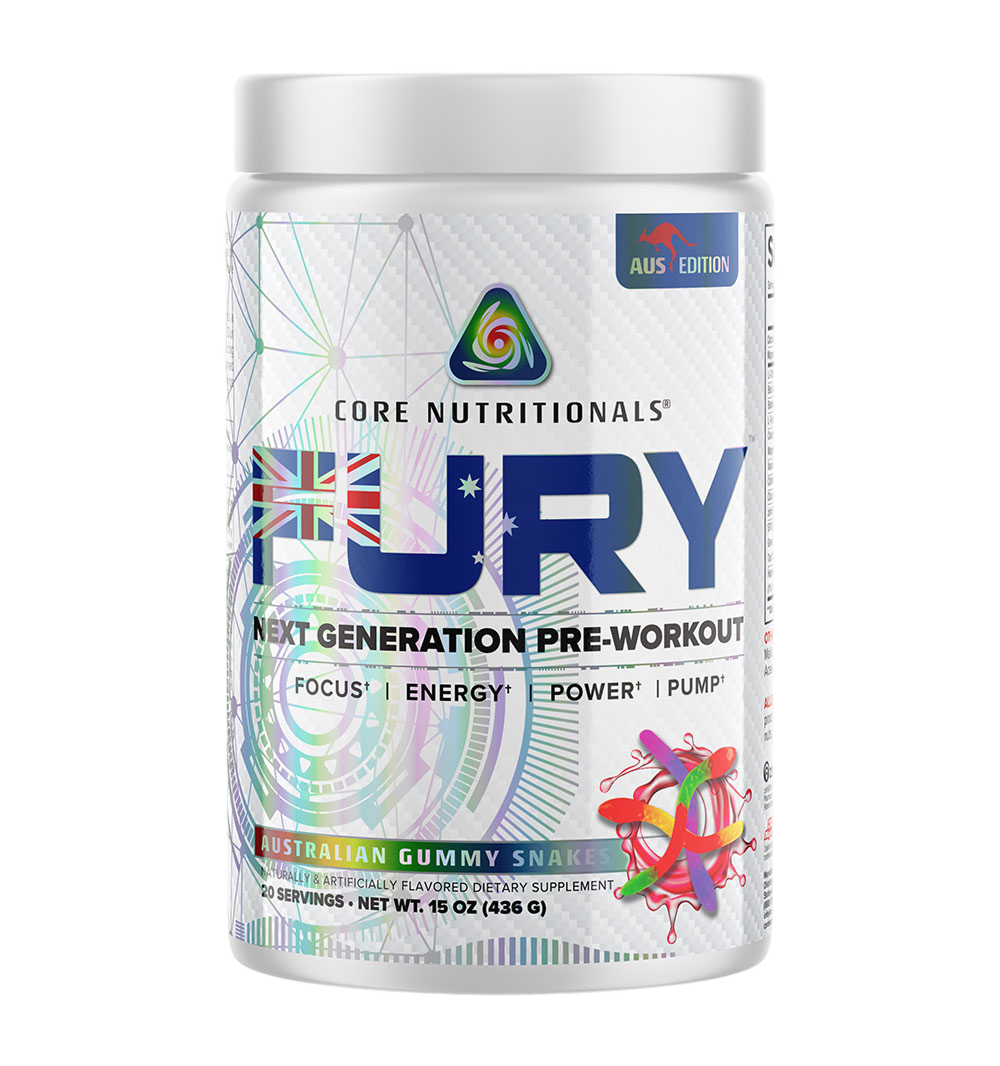
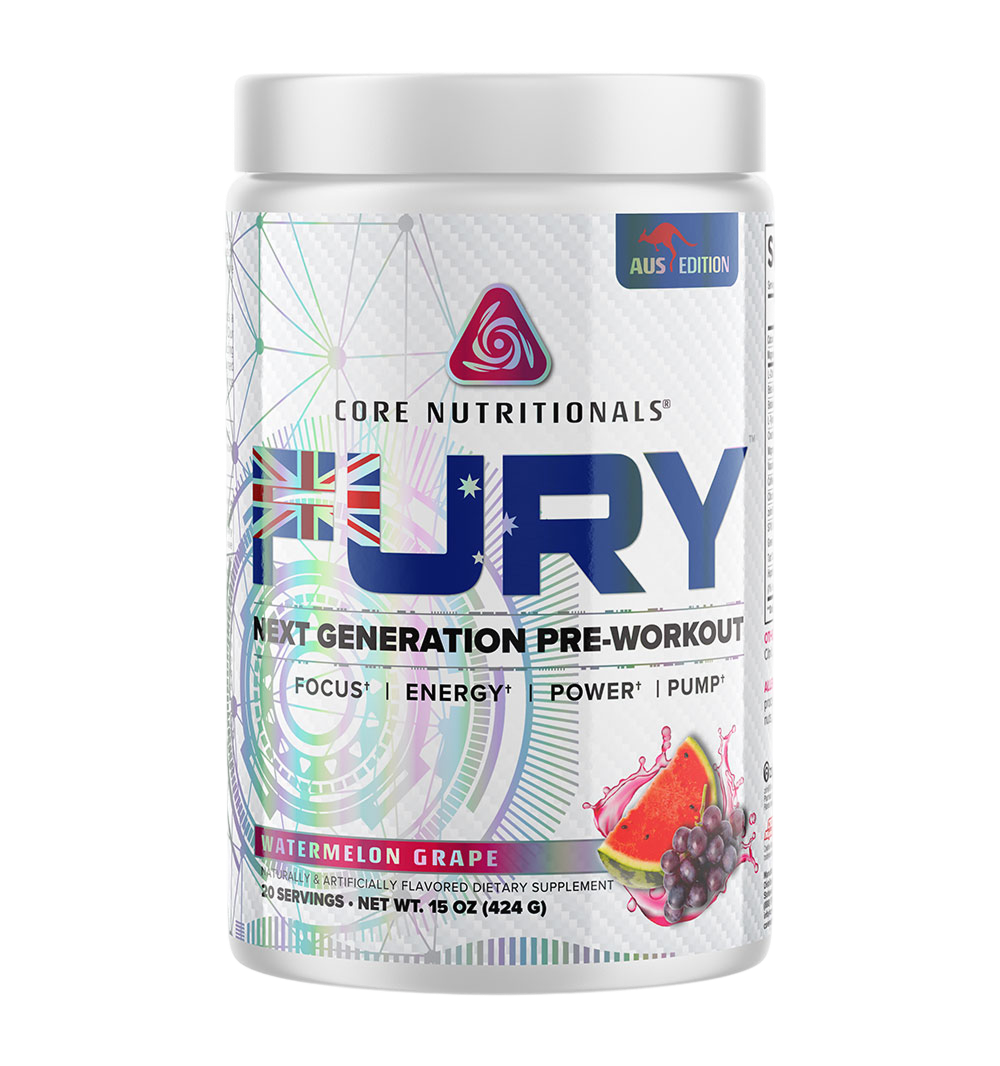
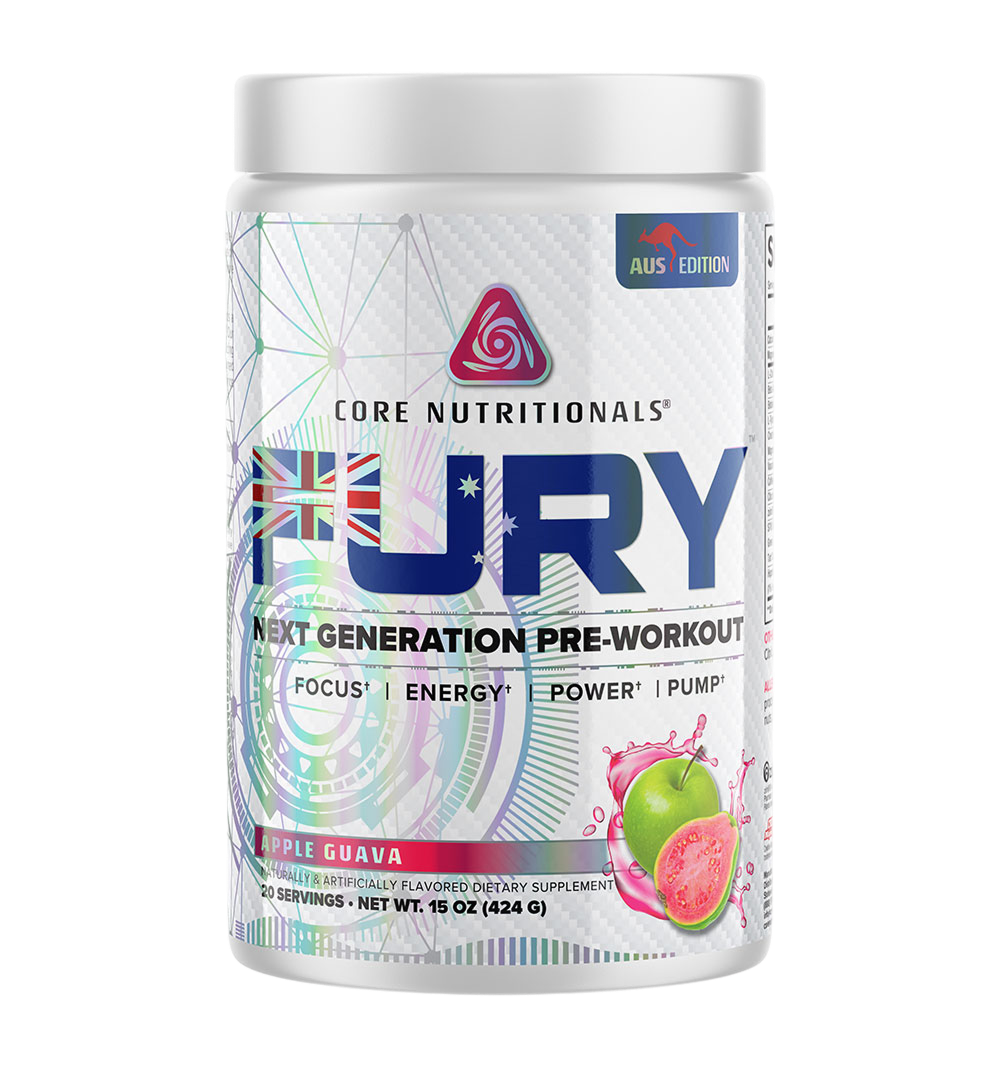
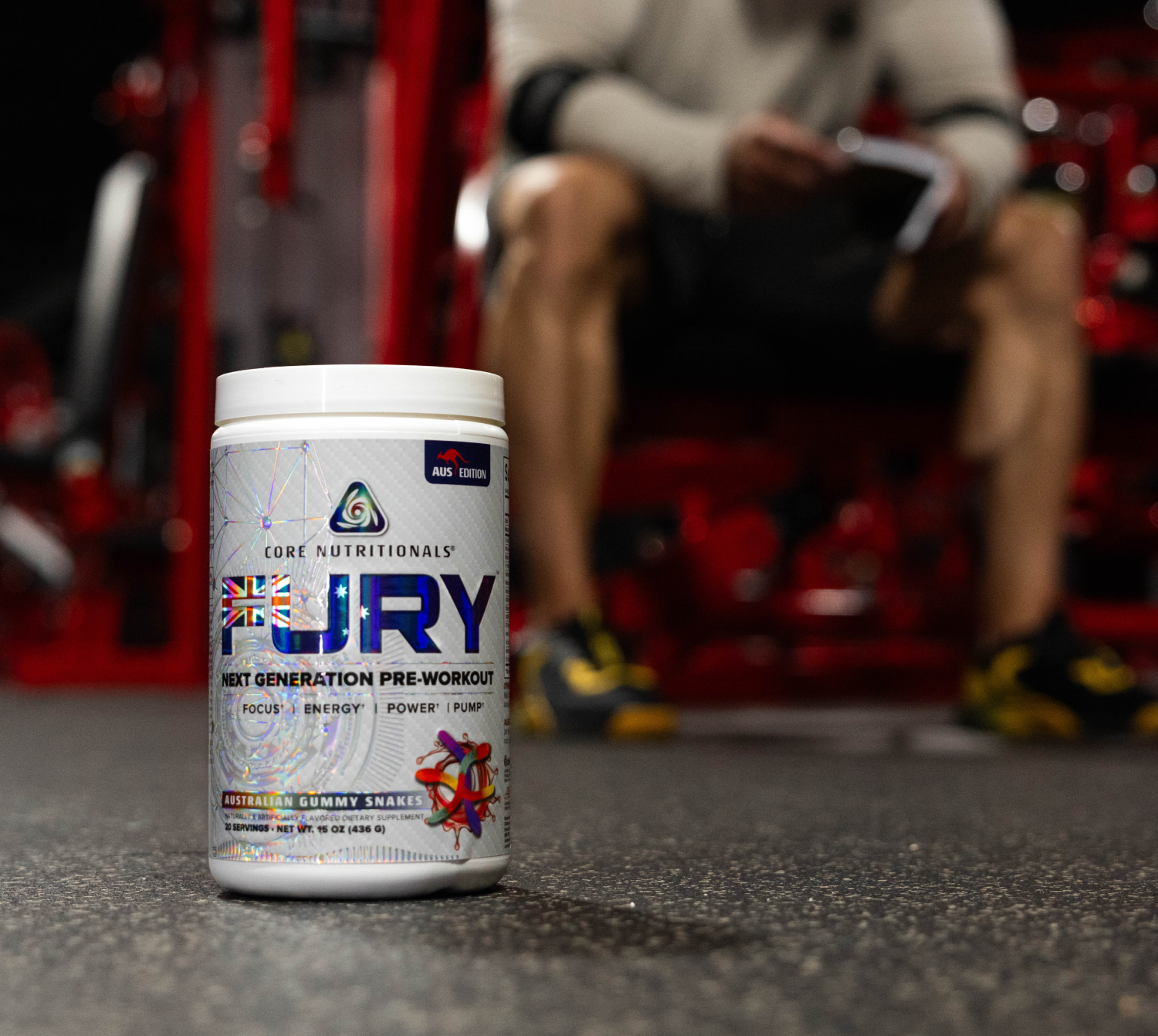
Pre-Workout
-
For this reason, Core FURY™ - the preeminent, single solution pre-workout on the market – has undergone progressive improvements on a regular basis since its inception in 2013. With each iteration, we’ve improved upon the last while refining and reinventing the category with a more complete and cutting-edge formulas. Enter Core FURY™ Australia.
Core FURY Australia is a precise mixture of key preworkout ingredients that enhance athletic performance and increase mental edge. For athletic performance, Creatine Magnapower™, l-citrulline, betaine anhydrous, S7®, and beta alanine are included at, or above, serving sizes suggested by the research. Collectively, these ingredients have been repeatedly demonstrated to increase maximum voluntary contractile force and other measures of power output, increase maximal oxygen uptake capacity, and significantly enhance time measures in standard athletic trials. For cognitive capacity, clarity, and focus, caffeine anhydrous, citicoline, and ZümXR are also included at, or above, serving sizes suggested by the research. Trials using these ingredients have shown them to increase working memory, reduce cognitive inhibition, and reduce neurological processes typically associated with cognitive decline. All of these benefits are key to creating an impactful and effective preworkout supplement.
Together, our performance and focus ingredients constitute the pinnacle of pre-workout formulas that earns a well-deserving spot amongst the pantheon of Core Nutritionals FURY™ products.
L-Citrulline
Citrulline is a non-essential, non-protein amino acid that forms during the urea cycle and forms ornithine when combined with carbon dioxide. Citrulline is also a critical source of endogenous (natural) arginine, as it is rapidly and efficiently converted to arginine in the vascular endothelium and other tissues
Citrulline’s benefits have been shown to be greater than its parent compound. While arginine undergoes direct hepatic (liver) metabolism through the enzyme arginase, citrulline bypasses hepatic metabolism entirely and it is delivered straight to the bloodstream. The result is that gut absorption and plasma (blood) bioavailability studies comparing citrulline and arginine have shown two things. First, that citrulline is less readily destroyed and has greater absorption than arginine. Second, that citrulline supplementation increases arginine levels more effectively than arginine supplementation itself.
This translates to promising results. For example, animal studies show a significant increase in anaerobic performance at a 250mg/kg/day serving of citrulline, while studies in humans implicate citrulline in both aerobic and anaerobic performance increases. As a critical part of the urea cycle, citrulline’s performance benefits are thought to be a result of its role in ammonia clearance. Citrulline is implicated in reducing the oxygen cost of muscle processes, along with increasing the rate of post-exercise ATP and phosphocreatine replenishment. As ATP and phosphocreatine are the body’s ‘exercise fuel,’ this may result in citrulline delaying time to exhaustion in aerobic and anaerobic exercise.
Beta Alanine
Carnosine is a bit of an odd duck: we know that it is crucial for muscle function, and that dietary sources of carnosine are essential, but we don’t know precisely how it’s working. Moreover, for decades, we had no idea how to increase intramuscular concentrations, as exogenous carnosine sources degraded in the body so fast as to be effectively useless.
Enter beta-alanine. Simply a different iteration of one of the amino acids that comprises carnosine itself (alanine), beta-alanine has proven to be the most effective means of significantly increasing intramuscular concentrations of carnosine – and therefore of promoting all of carnosine’s various beneficial effects on muscle performance. If that weren’t enough, beta-alanine has also demonstrated beneficial physiological effects independent of its parent compound. In order to understand why, though, we need to first understand some of the basics behind carnosine itself.
Carnosine, a cytoplasmic dipeptide synthesized from the precursors L-histidine and l-alanine, is present in high concentrations in skeletal muscle and plays a pivotal role as a, “chemical buffer” in myocytes (muscle cells). It has long been known that carnosine concentrations are highest in glycolytic, rather than oxidative muscle fibers (roughly speaking, explosive vs., endurance muscle fibers, respectively), and thus long hypothesized that this amino acid is required for sustained performance during supramaximal exercise. Recent research demonstrates that carnosine exerts its physiological effects in long hypoxic (low oxygen) drives by functioning as a high-capacity pH buffer in skeletal muscle, preventing the pH ratio of plasma from dropping too low – and therefore preventing crucial pH-dependent processes such as protein synthesis from being inhibited by acidosis.
Despite its critical role in skeletal muscle anaerobic performance, intramyocellular synthesis of carnosine is rate-limited by the availability of l-alanine. Unfortunately, the majority of literature demonstrates that attempting to increase intramuscular levels of carnosine via either direct carnosine or alanine supplementation is largely ineffective due to carnosine/alanine pharmacokinetics. Enter beta-alanine. Research with beta-alanine demonstrates consistent and dose-dependent increases to intramuscular carnosine concentrations with beta-alanine supplementation, with certain studies showing an increase of 40-60% with chronic administration. These same pieces of literature reveal a synergistic effect of exercise on beta-alanine supplementation, whereby the muscle adaptive changes associated with resistance training promote further intramuscular carnosine production in response to beta-alanine supplementation.
In simpler language, this essentially means that beta-alanine is a dietary supplement that promotes its own effects in combination with exercise. As you exercise, you simultaneously intensify beta-alanine’s physiological actions – both directly, as well as in the production of intramuscular carnosine. Once ingested, beta-alanine’s exercise-specific beneficial activity is well-established. Elevation of intramuscular carnosine content via beta-alanine supplementation has been shown to improve performance in the following ways.
-
Both acute and chronic increases in total work capacity, measured by total volume during exercise sessions.
-
Highly significant increases to TTE (total time to exhaustion), one of the most accurate and comprehensive measures of endurance. In various trials, beta-alanine supplementation has been shown to increase TTE by upwards of 20%.
-
Increases to total muscle power output in both acute and chronic trials, suggesting that beta-alanine’s most significant benefit is to those engaging in power-dependent resistance training.
In total, a significant body of research exists to suggest that beta-alanine may significantly increase muscle power output, strength, training volume and output, overall performance in hypoxic (oxygen-deprived) conditions and peak VO2 max (oxygen holding capacity).
These myriad benefits make beta-alanine both one of the most-studied, and most well-rounded dietary supplements. Beta-alanine not only has direct, actionable physiological effects, but also promotes critical muscle physiologic adaptations that promote its own effects.
Betaine Anhydrous
Betaine (trimethyl glycine) is found naturally in most living organisms. It is well known to protect non-mammalian animal life in conditions of osmotic stress (a rapid change in the amount of solute surrounding a cell), in addition to functioning as an osmolyte in mammalian (including human) tissues. Betaine is formed in cells as an oxidation product of choline and can be obtained in the diet from foods such as spinach and beets.
Though data on betaine is limited, and recent, the available literature suggests that this compound may have effects in a few areas. Studies on betaine using servings as little as 1.25g/day and up to 5g/day for up to 14 days have shown promising results. In one study, a 2.5g/day serving was found to enhance endurance and total repetition volume for the squat, bench press, and jump squat in in healthy-exercised trained adults. A similar study using the same serving found that betaine use increased peak power and maximum peak power, along with force and the maintenance of both force and power in healthy, exercise-trained subjects.
Perhaps more interesting, however, is a study which examined betaine’s effect on the endocrine system. This study revealed that betaine may exert an effect on several endocrine processes given the proper conditions, causing the authors to hypothesize that long(er) term betaine supplementation may increase the hypertrophic response to resistance training.
L-Tyrosine
Tyrosine is amongst a class of amino acids known as ‘non-essential’ amino acids, so called because the body can produce them endogenously, and it is therefore not essential to consume dietary tyrosine. That said, tyrosine is also what is known as a conditionally-essential amino acid; conditionally-essential because, along with glucose and ammonia, the synthesis of tyrosine additionally requires adequate levels of phenylalanine. Once synthesized, tyrosine is one of the most critical amino acids, given its prominent role as a substrate in the synthesis of the catecholamines dopamine, norepinephrine, and epinephrine, in addition to both T3 (triiodothyronine) and T4 (thyroxine) thyroid hormones.
In studies on stress modulation, tyrosine has been demonstrated to reverse stress-induced norepinephrine depletion and the depressant-behavioral effects normally associated with it. In simpler terms, tyrosine may, in certain conditions, dampen the extent to which norepinephrine is removed from the bloodstream during a stress event. In simpler terms still, tyrosine may help to mitigate the sense of depletion and fatigue felt at the end of a workout.
Tyrosine may also play important metabolic functions, mostly related to its role in synthesizing compounds which stimulate the nervous system. While not traditionally considered a sympathomimetic amine, studies which have coadministered tyrosine and stimulants demonstrate a synergistic effect. These studies suggest that tyrosine may potentiate the effects of both endogenous and supplemental norepinephrine and its mimetics (in the case of exogenous use) with respect to lipolysis, thermogenesis, and energy expenditure. Meaning that tyrosine may play a role in assisting norepinephrine to break up triglycerides and increase body heat transiently.
Creatine MagnaPower® Magnesium Creatine Chelate
Sometimes called the “grandfather” of dietary supplements, creatine is, along with caffeine, one of the most extensively studied dietary compounds. Certainly, it is the most well-studied ergogenic aid. Generally speaking, the extensive amount of data on creatine demonstrates that it positively contributes to dilation of the vasculature, plasma-nutrient mobilization, post-workout nitrogen retention and protein synthesis, along with dose-dependently increasing contractile force through ATP (adenosine triphosphate) provision (i.e., it helps support increased strength).
Creatine MagnaPower® is a unique combination of creatine and magnesium chelate that has been shown to enhance the absorptive properties of creatine into the target muscles. So, this allows for creatines ATP (adenosine triphosphate) replenishment capabilities to be dramatically enhanced. As a reminder, ATP is currency for your body to utilize for every cellular process. Without this currency, the cell will run dry and function will decline. The increased absorption is due to magnesium’s strong alkaline properties. During normal creatine absorption, a reaction takes place called the lactamation reaction, which reduces the bioavailability of creatine. The magnesium that is contained in MagnaPower acts as a buffer to this reaction and allows for more creatine to be available in the muscle cell. With Creatine MagnaPower® showing the ability to produce larger quantities of ATP, this means that muscle fiber contractions are able to be more forceful and happen more often, which is an excellent combination for increases in muscle mass and strength at a more efficient rate.
The most recent research on creatine alone suggests that it exerts direct effects on muscle metabolism, including altering the expression of genes responsible for ribosomal assembly, attenuating the breakdown of leucine, and most famously, by expanding cell volume. Cutting through the jargon, let us just say that the amount of creatine in Core FURY Australia simply works: these servings have been shown time and again to significantly increase lean body mass and muscle volume, lower fatigue, and improve performance (measured in several ways) and when you put it in as a form that is shown to increase its efficiency and bioavailability, you are able to reap larger benefits of this powerful compound.
VasoDrive-AP®
VasoDriveAP® is a proprietary ingredient derived from fermented casein. The fermentation process produces two lactotripeptides, Valyl-Prolyl-Proline (VPP) and Isoleucyl-Prolyl-Proline(IPP). Based on the available clinical evidence, these tri-peptides work together to reduce angiotensin converting enzyme (ACE).
In a recent meta-analysis researchers found 30 studies – all of which were randomized and some of which were double-blind – wherein Valyl-Prolyl-Proline (VPP) and Isoleucyl-Prolyl-Proline (IPP), either alone or in combination, exerted a statistically significant effect on improving endothelial function. In one of the analyzed studies, 25 men were challenged with casein hydrolysate standardized for tri-peptides in a randomized and placebo-controlled design. At the conclusion of the study, forearm blood flow, a key measure of endothelial function, was found to be increased by 33%. The researchers in this and other studies demonstrate that the tri-peptides that constitute VasoDriveAP® exert an inhibitory effect on ACE. ACE, in turn, is a critical component of the renin-angiotensin (RAS) system, which regulates hemodynamics by controlling plasma fluid volume. While the precise mechanism has not been elucidated, researchers believe that the lactotripeptides in VasoDriveAP® competitively inhibit ACE, thus decreasing the metabolism of bradykinin and systematically dilating the arteries and veins.
Caffeine Anhydrous
Caffeine is one of the most widely consumed, and perhaps one of the most reviewed, psychoactive compounds. Its physiological effects in a range of areas have been well-documented, including exercise performance, information processing, alertness and mood enhancement, attention, and awareness, along with its anti-lipogenic and lipolytic abilities.
Most importantly to Core FURY, caffeine has been shown to have significant effects on exercise performance, even with ingestion in servings as small 3 to 9mg/kg/bw/day (the equivalent of 2 cups of standard coffee, for a 170lb male). In endurance training, possible explanations for caffeine’s performance-enhancing effects lie in its metabolic effects on both lean and fat tissue. It is suggested that caffeine’s potent lipolytic (the breakdown of fat tissue into fatty acids) and oxidative (the actual ‘burning’ of fat) action allow the body to utilize these sources during prolonged submaximal exercise. As a consequence, muscle glycogen is spared and available for use later in the training session. Practically speaking, this means caffeine is forcing your body to preferentially use fat tissue as a fuel source, while sparing the glycogen which gives you the full-bodied look!
In short-term exercise, caffeine’s demonstrated role in the inhibition of cyclic AMP- phosphodiesterase’s (PDE), adenosine receptor antagonism, and adrenoreceptor agonism come into play. These three pathways collectively stimulate lipolytic activity, boost fat metabolism, increase metabolic rate and energy expenditure, and regulate the body’s thermogenic activity. The practical results of activating these pathways are increases to the contractile force of both cardiac and skeletal muscle (harder flexion), an increase in energy expenditure (freeing up more caloric energy to be used in contraction), dilation of vasculature (better blood flow), and improvements to both nitrogen retention and skeletal muscle protein synthesis (key components to muscle building).
In Core FURY Australia, we have included a per-serving amount of caffeine that is neither excessive, nor arbitrary, but that instead reflects the servings used in clinical research.
Citicoline (Cytidine 5′-diphosphocholine)
Choline is an essential nutrient involved in numerous metabolic pathways, including DNA regulation and repair, protein function, and metabolism. Perhaps most importantly, the critical neurotransmitter acetylcholine is produced directly from free choline via cholinergic neurons. Acetylcholine is then responsible for several functions itself, most crucially as the compound which induces muscular contraction, and as the neuromodulator partially responsible for modulating risk/reward, arousal, and enhancing memory.
Choline’s essential role as a substrate for acetylcholine, and therefore brain development, is well documented in animal models. These studies demonstrate that levels of free maternal choline have a direct and fundamental impact on prenatal brain development, with the enhancements or deficits lasting into adulthood. Choline’s enhancing effect is particularly prominent in the hippocampus. In humans, the hippocampus is primarily involved in the consolidation of memory (taking short, episodic memory and translating it into long-term memory) and the learning of new information. Acetylcholine is a critical component in these processes, as mentioned above, and choline may therefore play a potential role in these processes as well by providing the substrate for acetylcholine synthesis.
Tartaric acid occurs naturally in the food source, while its salt derivatives (tartrate, for example) have been used as acidulants, antioxidant synergists, buffers and sequestrants. As free base choline is rapidly destroyed in metabolism, attaching a salt to enhance absorption is necessary. The bitartrate salt addition preserves choline from being destroyed during metabolism.
CDP-choline, or citicoline, is a cytidine molecule bound to a choline molecule via two phosphate groups (hence the diphosphocholine). The principal difference between standard choline supplementation as, say, choline bitartrate, and citicoline, is that citicoline is a cytidine supplier in addition. The combination of cytidine and choline in a single-source confers not only the direct effects of each ingredient on cognition and memory – but also factors significantly into choline biosynthesis
S7®
S7® is a low dose, but high power, blend of 7 (hench the name) plant-based components that have been clinically shown to increase nitric oxide (NO) production at extremely large amounts. These ingredients contain green coffee bean extract, green tea extract, turmeric extract, tart cherry, blueberry, broccoli, and kale. Some of the NO increases seen from this ingredient blend have been of upwards of 230%. This may not mean like much of an importance to the common individual, but to the individual who is serious about their training this can be extremely vital. Not only does nitric oxide act as a vasodilator, increasing blood flow to working tissues, it also aids in the delivery of oxygen and other key nutrients to active muscles during their use. This delivery of nutrients can also aid in recovery and decrease muscular fatigue, which will allow for more intensity during training session as well greater longevity during said training sessions. So how else does S7® work? It also works through a process called redox signaling modulation. Redox signaling molecules are produced naturally within our cells and are produced through the reorganization of H2O and NaCl molecules. Some of these messenger molecules roles are to defend other cells, repair damaged cells, or to replace damaged cells with healthier ones. This process serves as a first line of protection against the accumulation of oxidative stress and damage, much of which can be seen with intense training. Having healthy levels of redox signaling and the related oxidants has been hypothesized to be crucial for understanding optimal health. One double-blind, crossover, placebo-controlled study investigated this hypothesis and came to the conclusion that S7®, and its potent blend of antioxidant rich components, were able to positively affect cellular redox signaling and modulate certain inflammatory markers that can be detrimental to athletic progression.
Züm-XR ® XR Caffeine (provides 50mg caffeine):
Züm-XR is a patented coating technology that allows the dissolution profile of certain ingredients, primarily caffeine, to have a longer lasting affect in blood serum levels. The release of those ingredients is initiated by an abrasion in the stomach and pH levels between the stomach and the upper gastrointestinal tract. The coating of the microbead technology is a patented timing system with pharmaceutical grade safe polymers. Comparatively speaking, the dissolution profile of Züm-XR caffeine to your typical immediate release caffeine showed that Züm-XR took a far greater amount of time, well over 120 minutes to complete the process of dissolution.
Huperzia serrata Extract (leaf and stem) (1% Huperzine A):
Huperzia serrata is a compound found in the plant families of Huperziaceae, Lycopodiaceae, and Selaginella.and is endemic to China. The Lycopodium alkaloid Huperizin-A, found in Core FURY Australia, was first isolated from a folk medicinal preparation in 1984.
Due to the potent anticholinesterase activities of Huperzine A, the compound was been evaluated in numerous in vitro, in vivo, and human trials. These data suggest that Huperzine’s Ache activities are most potent in the cortex, hippocampus, and striatum (at least in rats) – key regions in the brain responsible for forming, coordinating, and recalling memory. These effects are assisted by Huperzine A’s high oral bioavailability. Studies using microdialysis technique in rats, for example, showed that the response to Huperzine A was dose-dependent and substantially lowered the level of ACh in cortex
Huperzine A has also shown promise in humans. In a study on memory and learning performance, 34 pairs of middle school students complaining of memory inadequacy were given a small dose of Huperzine A. The students were then match paired along a number of vectors and provided tests on working memory. The results of this study exhibited that HupA markedly improved the memory function of adolescent students.
-
-


